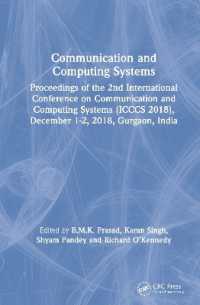- ホーム
- > 洋書
- > 英文書
- > Psychology
Full Description
In November 2015, The Winnicott Trust held a major conference in London to celebrate the forthcoming publication of the Collected Works of D. W. Winnicott. Most of the papers given then now constitute the chapters in this book. It not only reflects the ongoing contemporary relevance of Winnicott's work, clinical and theoretical, but these chapters demonstrate the aliveness of Winnicott's contribution as present day practitioners and academics use his ideas in their own way. The chapters range from accounts of the early developmental processes and relationships (Roussillon, Murray), the psychoanalytic setting (Bolognini, Bonaminio, Fabozzi, Joyce, Hopkins) creativity and the arts (Wright, Robinson), Winnicott in the outside world (Kahr, Karpf), to the challenge to the psychoanalytic paradigm that Winnicott's ideas constitute (Loparic). The phrase 'the history of the present' draws on Foucault's radical reconsideration about how to think about history and the present, using a so-called genealogical rather than an archaeological model Using this genealogical concept in relation to our thinking about Winnicott, his ideas, where they sit in psychoanalytic theory and psychoanalytical clinical development, reflects the breadth and depth of his work. Not only does it refer to his interest in the history of people, children, what happens to them in the very beginning of their lives, how that is manifested later adulthood, but it refers to the genealogy of his ideas in the psychoanalytical movement. He sits in a particular relationship to Freud and Klein and we now think of him in terms of a very rich history of psychoanalytic thinking. The ideas of family, of richness and complexity of relationships within a genogram, is a very helpful way of thinking about Winnicott and our relationship with him.
Contents
Preface , Introduction , Emergence and conception of the subject (self) , In between sameness and otherness: the analyst's words in interpsychic dialogue , An investigation into the technical reasons Winnicott proposes that the analyst's objective hate towards the patient has to eventually be made available for interpretation , Meeting Winnicott , There's no such thing as a baby: how relationships support development from birth to two , The irrepressible song , Creativity in everyday life (or, Living in the world creatively) , Images and words: some contemporary perspectives on the concept of regression , The public psychoanalyst: Donald Winnicott as broadcaster , Beyond the consulting room: Winnicott the broadcaster , Winnicott's paradigm shift in psychoanalytic theory and practice








